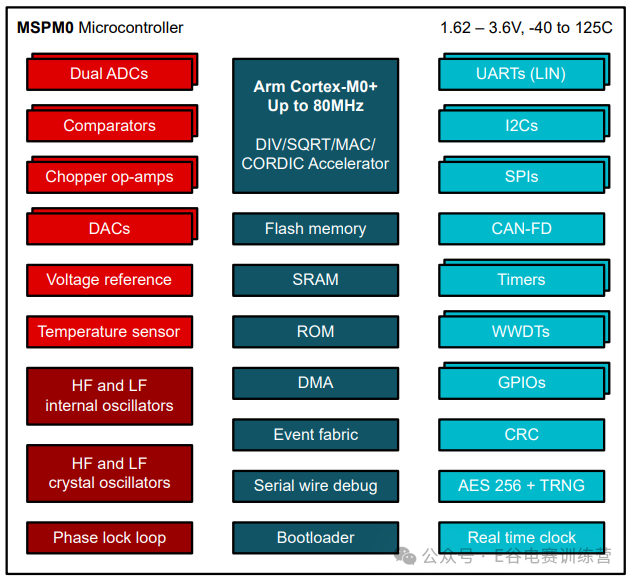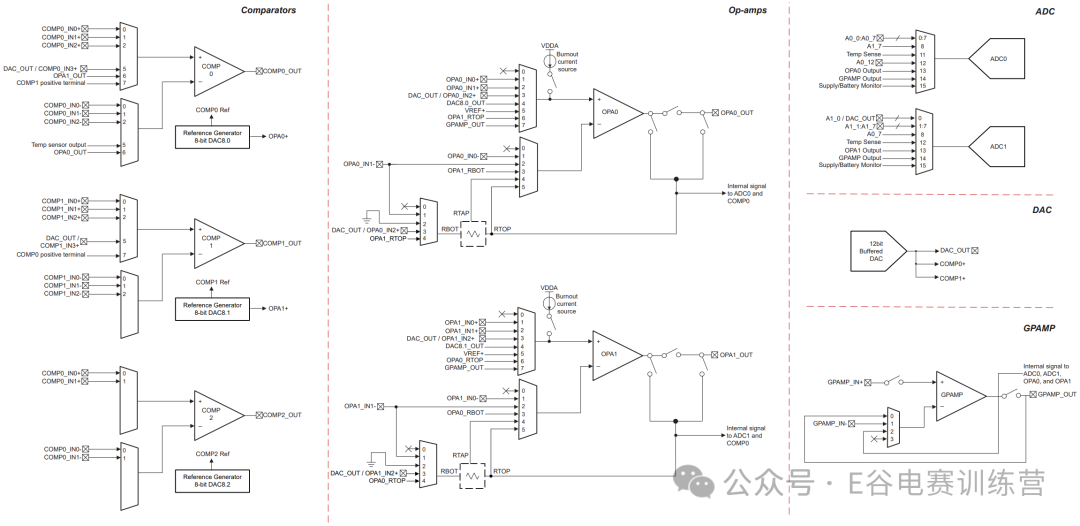Skip to content
2025 E Valley Cup Electronic Design Competition
Special Track – Ultrasonic Follow Car
Since 2016, the National College Student Electronic Design Competition has been sponsored by TI. Since then, there has been a question each year requiring the use of TI’s MCU. In 2023, TI released the Cortex-M0+-based mixed-signal MCU MSPM0 series to replace the previous 16-bit MSP430, gradually shifting the focus of the MCU product line from other series including MSP430, MSP432, and Tiva C to MSPM0.
MSPM0 is equipped with a Cortex-M0+ CPU with a maximum frequency of 80 MHz and a mathematical accelerator peripheral, featuring up to 256 KB of flash, up to 32 KB of SRAM, and various commonly used embedded peripherals (SPI, I2C, UART, timers), particularly excelling in mixed-signal capabilities (taking MSPM0G3507 as an example):
1. Two 4 MSPS, 12-bit ADCs that can sample simultaneously;
2. One 1 MSPS, 12-bit DAC;
3. Two chopper operational amplifiers, configurable as programmable gain amplifiers;
4. One general-purpose operational amplifier;
5. Three high-speed comparators, each with an 8-bit DAC as a reference.
In the 2024 TI Cup Electronic Design Competition, Problem B “Single-Phase Power Analyzer” specifies the use of TI MCU, while Problem H “Automatic Driving Car” specifies the use of the MSPM0 series MCU. It is foreseeable that future electronic design competitions will continue to promote the MSPM0 series, so it is necessary to make some relevant preparations to have more options during the competition.
Due to my limited energy, the E Valley guidance point cannot provide systematic MSPM0 embedded training in the short term, but there are already systematic materials available online. Therefore, we hope to encourage students through this track to self-learn the use of MSPM0 series MCUs and complete an interesting project. This project is adapted from a course project, which most students should be familiar with.
Produce two devices: a handheld transmitter and a car.
Transmitter requirements:
1. Battery powered (either dry battery or lithium battery, same below), with an interface for power consumption measurement;
2. If using a programmable device, it must be an MSPM0 series MCU, and commercial core boards cannot be used.
2. Must include an MSPM0 series MCU on a self-designed PCB, and commercial core boards cannot be used.
3. When the car receives the ultrasonic signal from the transmitter, it should move towards the transmitter;
4. When the car cannot receive the ultrasonic signal from the transmitter, it should spin in place to search for the transmitter;
In the ultrasonic signal conditioning part (including the transmitter and the car), minimize the use of active components and utilize the internal resources of the MCU as much as possible; the fewer active components outside the MCU, the better, as this is the primary scoring criterion.
Additionally, write a technical report of no more than 8 pages A4, introducing the overall design of the car system, the plans for ultrasonic signal transmission and reception, the production process, and reflections.
Obstacle Avoidance direction must be based on ultrasound and needs to achieve:
1. When the car detects that it is very close to the transmitter, it can automatically stop;
2. No matter how the transmitter guides the car, the car will not hit obstacles; the car will only move forward when the transmitter is in a direction without obstacles.
Communication direction needs to achieve:
1. In the presence of other ultrasonic transceiver systems at the evaluation site, the car can follow the matching transmitter without being misled by other transmitters;
2. The transmitter can control resources on the car through ultrasound, including LED, buzzer, and adjusting the car’s speed, moving forward and backward, etc.;
3. The transmitter’s power consumption should be as low as possible.
In the entire design, the following devices or modules are not allowed:
1. Any programmable device other than MSPM0;
2. Commercial MSPM0 core boards (the PCB containing MSPM0 must be self-designed, and design files must be presented during evaluation);
3. Commercial ultrasonic modules (can be self-made, but it is recommended to directly design it on the board instead of as a separate module);
4. Various wireless communications other than ultrasound, including but not limited to infrared, Bluetooth, etc.
The following functional modules are allowed to be used:
1. Battery protection and charge/discharge management;
2. Power management such as switch power supplies, linear regulators, etc.;
This track focuses on the participants’ mastery of MSPM0 devices and related analog circuits. Therefore, the primary scoring criterion is the number of active devices in the ultrasonic transceiver circuit; the fewer, the better, based on the total number of transmitters and cars. The counted devices include:
1. BJT and MOS (the first two are not counted, thereafter counted at half quantity);
2. Operational amplifiers (counted by instance number, e.g., one LM324 counts as 4);
3. Comparators (counted by instance number);
4. Analog switches (counted by package number, e.g., one 74HC4053 counts as 1);
5. Logic gates (counted by package number);
6. Various integrated circuits (counting depends on the specific situation).
Non-counted components, i.e., passive components, include resistors, capacitors, inductors, diodes, etc. Internal resources of MSPM0 are not counted. If an MSPM0’s internal resources are insufficient, consider using two, but you may need to solve the communication issue between the MCUs; it is also not recommended to exceed 2. Additionally, active devices unrelated to ultrasound are not counted, including motor control, buzzer drive, etc.
Q: What does it mean that the number of active devices is the primary scoring criterion? Is a design that does not use external operational amplifiers better than a design that uses one operational amplifier to achieve the exploitation section’s functionality, even if it only meets the basic requirements?
A: It means that the number of active devices carries significant weight. When the number of devices is similar, we appreciate complete designs more, but if achieving ultrasonic communication requires 10 operational amplifiers, it is hard to appreciate that.
Q: Regarding the aforementioned number of active devices, can you provide a reference for how many is reasonable?
A: We believe that one MOS can achieve the basic requirements, used on the transmitter to drive the emission head, and the receiver fully utilizes the internal mixed-signal resources of the MSPM0. To achieve the functionality of the exploitation section, two MOS (counted as 0) should be sufficient; not exceeding 2 is competitive.



